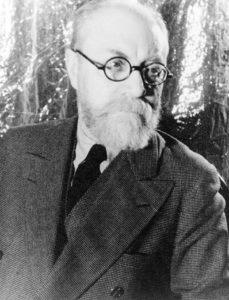Last November, the State Collection of North Rhine-Westphalia in the German city of Düsseldorf received attention after it came to light that a work by the Dutch modernist Piet Mondrian had been hanging in their galleries upside-down for several decades. However, this is far from the first time someone has accidentally hung a work upside-down. In 1961, the Museum of Modern Art in New York opened a new exhibition, The Last Works of Matisse, which included Le Bateau. This was a paper-cut design painted with gouache, a simple depiction of a boat on the water with its reflection mirrored below it. The work was created in 1953, making it one of the last works Matisse ever created before he died in 1954.
MoMA opened the show on October 18, 1961. But forty-seven days later, a museum visitor named Genevieve Habert walked through the galleries and came upon Le Bateau. However, she noticed something rather strange. Both the boat and the purple outline of the clouds seemed more complex on the bottom than on top, which Habert deduced was very uncharacteristic of Matisse. After three visits to the exhibition and getting her hands on the show’s catalogue, she concluded that the work must have been hung upside-down by mistake. This had gone completely unnoticed by museum staff and the hundred thousand people who had visited the exhibition in those six weeks. Habert notified an attendant, who then went to the museum director, Monroe Wheeler. The Matisse was quickly and quietly taken down and rehung the right way around. However, that didn’t stop The New York Times from getting a hold of the story. According to interviews, a museum employee accidentally hung it upside-down because the label affixed to the back of the work was applied upside down. It is not known whether this means the work had been exhibited upside-down previously.
For another example, in 1965, London’s National Gallery accidentally hung Van Gogh’s Long Grass with Butterflies upside-down. A visiting schoolgirl pointed this out about fifteen minutes after staff returned the painting to the gallery wall after removing it for photography. In 1994, London’s Hayward Gallery unintentionally hung Salvador Dalí’s 1928 oil painting Four Fishermen’s Wives of Cadaqués upside-down while on loan from the Reina Sofía Museum. Writers for The Art Newspaper noticed this because of a phallic shape featured on the canvas. “Dalí would hardly have made it point downwards,” wrote Martin Bailey. In 1986, the University of Minnesota Art Museum embarrassingly admitted that one of its most treasured paintings, Georgia O’Keeffe’s Oriental Poppies, had been on the gallery walls hanging vertically instead of horizontally, as intended, for nearly thirty years.
However, some works are actually displayed upside-down rather intentionally. This could be because of an optical illusion, like the works of Giuseppe Arcimboldo. Or, perhaps, it is to make a statement. For example, the portrait of King Philip V of Spain by Josep Amorós is on display at the Almodí Museum in Xàtiva, a town in Valencia. Now, Philip V does not exactly have the best reputation in the town. During the War of Spanish Succession (1701 – 1715), the king laid siege to the town and nearly burned it to the ground. Therefore, the king’s portrait is on display at the museum but is intentionally hung upside-down as a small act of petty vengeance.

